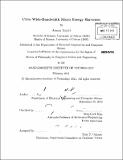Ultra wide-bandwidth micro energy harvester
Author(s)
Hajati, Arman
DownloadFull printable version (24.78Mb)
Other Contributors
Massachusetts Institute of Technology. Dept. of Electrical Engineering and Computer Science.
Advisor
Sang-Gook Kim.
Terms of use
Metadata
Show full item recordAbstract
An ultra wide-bandwidth resonating thin film PZT MEMS energy harvester has been designed, modeled, fabricated and tested. It harvests energy from parasitic ambient vibration at a wide range of amplitude and frequency via piezoelectric effect. At the present time, the designs of most piezoelectric energy devices have been based on high-Q linear cantilever beams that use the bending strain to generate electrical charge via piezoelectric effect. They suffer from very small bandwidth and low power density which prevents them from practical use. Contrarily, the new design utilizes the tensile stretching strain in doubly-anchored beams. The resultant stiffness nonlinearity due to the stretching provides a passive feedback and consequently a wide-band resonance. This wide bandwidth of resonance enables a robust power generation amid the uncertainty of the input vibration spectrum. The device is micro-fabricated by a combination of surface and bulk micro-machining processes. Released devices are packaged, poled and electro-mechanically tested to verify the wide-bandwidth nonlinear behavior of the system. Two orders of magnitude improvement in bandwidth and power density is demonstrated by comparing the frequency response of the system with that of an equivalent linear harvester with a similar Q-factor.
Description
Thesis (Ph. D.)--Massachusetts Institute of Technology, Dept. of Electrical Engineering and Computer Science, 2011. Cataloged from PDF version of thesis. Includes bibliographical references (p. 189-197).
Date issued
2011Department
Massachusetts Institute of Technology. Department of Electrical Engineering and Computer SciencePublisher
Massachusetts Institute of Technology
Keywords
Electrical Engineering and Computer Science.